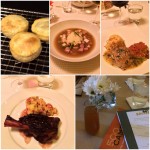On a vacation trip with the Hubbz 3-4 years ago, we found out about this little eatery in Bocas del Toro, Panama, it is called Guari Guari. We had a phenomenal 5 or 6 course meal prepared by a husband and wife team and served al fresco, in an area that was not much more than their private patio. The ‘restaurant’ seats 10 people each night and, as long as you don’t have special dietary requirements, you’re dazzled by the chef’s whim and exquisite palate.

I’ve long dreamed of having a little place, maybe a B&B with a restaurant offering limited seating and serving dinners for our guests and maybe have a table or two open for locals. I have to admit that Guari Guari certainly stayed in the back of my mind until recently, when I began my Secreto dinner series. You can come here to get a peek at what I’ve been doing over the past few months, together with a few shots–taken when I remembered to leave the kitchen and grab the dang camera! I will also offer recipes for some of the dishes I’m preparing, I mean, this is a food blog, after all!
my very first menu and the beginning of the Hubbz and my homegrown adventure.
Welcome Cocktail and Appetizer: Cava cocktail and Pasteis de Pollo (Pastry empanadas filled with chicken / Wine pairing: Spanish sparkling wine cocktail)
1st Course: Sancocho Panameño (A traditional Panamanian chicken soup with root vegetables and rice / Wine pairing: Kung Fu Girl Riesling)
2nd Course: Filet of Grouper al Ajillo with Saffron-A-Roni and Chayote Gratin / Wine pairing: Felino Malbec
3rd Course: Leg of Lamb in Star Anise Mole with a Potato and Leek Hash / Wine pairing: Chateux-Croix Mouton Bordeaux
Dessert: Passion Fruit Napoleon (Phyllo sheets topped with a passion fruit curd and pistachio brittle) / Wine pairing: Urban Uco Torrontes

For the Passion Fruit Napoleon, which was a major hit, I baked phyllo sheets brushed with butter and with a sprinkle of sugar until golden and assembled them with passion fruit curd and topped it with candied pistachios and strawberries. Simply delicious!
Cookingly yours,


One door closes…
It’s been 3 years since my last post. Life got hectic, nomadic and I just lost the joy that cooking and blogging brought to it because I always seemed to be chasing the clock. The pressure I put on myself made it feel like another job, it was no longer my time to envision, create and be delighted by the dance of spices and fire. As always, life is in constant flux and things have slowed down and are different. Day job priorities have shifted, new business decisions were made and with that I’ve refocused as well.
I might’ve shared this before, but part of the reason things were so out of balance these past years, was a possible move to the South America region to grow the department I work in. That was certainly an exciting prospect, one that required a lot of travel to set the groundwork. It was crazy, I tell you! I traveled over 60k miles in 2012 and 2013, which allowed me to see some beautiful places, meet amazing people and eat incredible food. However, as it often happens, goals were reexamined, departments were restructured and new decisions were made. So no transfer for me, at least not as a result of my day job. It has taken time to get over that realization, to let go of those dreams and plans for a life in a different locale.
As I mourned that loss, I found myself slowly getting back to that joyous space, back to the solace my tiny old kitchen so kindly offers me. Between the memories of my travels and my continued obsession with food channels, programs and books, my cooking is much more inspired and inventive. I remember everything I saw and ate and experienced in the past two years, so they weren’t a loss; instead, I’ve translated it all into the flavors that now come from my kitchen. A new dream is beginning to be dreamt and defined and it has something to do with a new way to share the joy of cooking and eating and visiting with people as obsessed with food as I am. Well, maybe not AS obsessed as I am, but still avidly curious.
Two different things will be happening here: I’ll post about the places, things and foods from my travels; so if you’ve always dreamed of visiting some of the countries in South America but haven’t made it yet, or if you moved away and are feeling nostalgic about home, or if you just love to hear stories and talk about food, then this is the blog for you. The other focus is molding an emerging dream, though I’m not sure what the final destination will be yet. A few months ago I began opening my doors to ten diners and serving them the dishes I create. I’m part of the underground, the pop up dinner circuit, I’m cheffing for strangers! At least, that’s the plan. I’m about to host the 5th of these dinners and my friends keep signing up for them. I’m surrounded by an amazing and supportive group of friends and I know that as these develop, more and more people will come into my circle and I’ll be able to share with them the fascinating food from this continent.
As for you, unless you’re in Houston and can come to one of my dinners, I invite you to sit with me while I rediscover my old digital files, recollect life changing moments and tell you about the food. Oh, the food of South America and mine.
Cookingly yours, again,

As I browse through my blog, I can’t help but notice how often rice seems to come up. I really can’t help it, I have a love affair with that little grain. My only hope is that I offer some variety for you. That said, this is a rice post. Yep. Mas arroz.
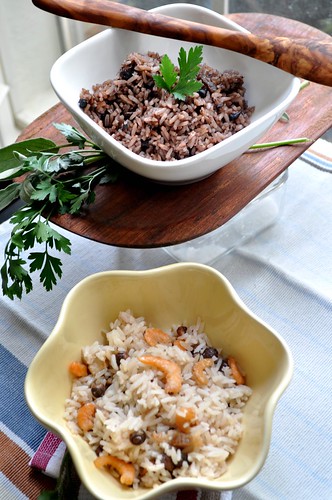
In Panama, we prepare rice in many different ways; sometimes with coconut milk, or various beans and peas. Anything you want, really. Two of my favorites are Arroz con Frijoles Negros (rice with black beans) and Arroz con Camarones Secos (rice with dried shrimp).
They’re both easy to make and follow the same process as the recipe for Arroz con Guandú. For the black beans, I used dried beans and cooked them in the coconut milk, as detailed in the recipe below, but you can use canned beans . For the one with the dried shrimp and guandú, I cooked both of those in the coconut milk first, then followed the recipe.
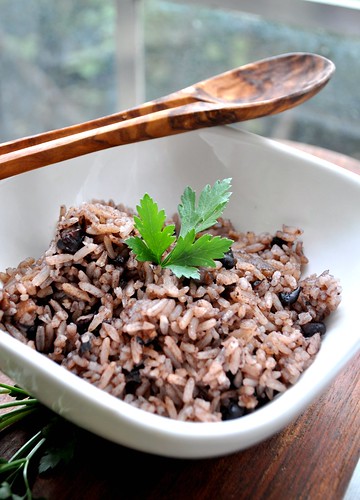
For the Arroz con Coco y Frijoles Negros (Black beans & rice)
2 cps rice
1/2 cp dry black beans
2 cps coconut milk
3 cps water
1/3 cp salt pork or bacon
1 tbsp vegetable oil

For the Arroz con Camaroncitos Secos y Guandú (Rice w/dried shrimp & pigeon peas)
2 cps rice
1 cp frozen guandú (pigeon peas)
1/2 cp dried shrimp
2 cps coconut milk
3 cps water
1/3 cp salt pork or bacon
1 tbsp vegetable oil
Method for both versions:
In a pot with a tight-fitting lid, brown the salt pork/bacon rendering some of its fat. Add the guandúes (pigeon peas), coconut milk. Bring it to a boil, then reduce the heat until it simmers. Cook it until the peas are tender, about 40 minutes. Strain the liquid and measure, add enough water to make 3-1/3 cps of liquid, set aside.
This recipe uses the frozen peas, however, if you are using the canned variety, just skip the step above. Instead, drain, rinse and strain the beans, then add coconut milk and water to measure 3-1/3 cups. Fry the salt pork or bacon just before adding the rinsed rice.
Add oil to the pan with the peas, rinse the rice and add it to the pot stirring all the ingredients. Add the liquid, check the salt, stir this well. Make sure you remove any drippings that may have been stuck to the bottom of the pan. Bring it to a slow boil; once the liquid boils do not stir it again. Keep the temperature on medium high.
Once the liquid is almost completely evaporated, bring the temperature to low and cover with the lid. Allow to steam undisturbed for 40 minutes. When you remove the lid, all the peas will be at the top, go ahead and stir them into the rice. You’re done!

Note: The flavor of the coconut milk will intensify with time. You can cook the peas a day ahead to allow the flavors to meld together.
Do you believe soups are better suited for a specific time of the year? Maybe when it is cold and dreary or rainy outside? For Panamanians, soup is on any day of the week and year. As a matter of fact, you’ll find it on the daily lunch menu at every restaurant or Fonda around the country.
When I was in Austin a few weeks ago, I saw an advertisement for Sopa de Arroz con Pollo (Chicken & Rice Soup). Even though I’ve heard about chicken & rice soup, I never really thought about it in a Latin context until then. Chicken & rice soup doesn’t move me in any way, but Sopa de Arroz con Pollo…? Now, that’s a completely different matter. I simply couldn’t get it off my mind. The possibilities. The potential goodness. Muy rico.
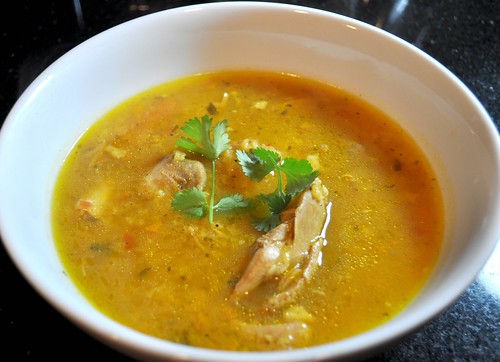
It turned out lighter than I had anticipated, even with the addition of the rice. Rich with the flavors of the chicken broth and culantro. I didn’t have any yuca at home, but next time I make it, I will use that instead of potatoes. And it was a breeze to make too!
Sopa de Arroz con Pollo
1-1/2 lbs of chicken on the bone (I prefer thighs) seasoned with 2 pkts Sazón Goya .
To your blender, add 1/2 onion, 1/2 red bell pepper, 1/4 cp cilantro or 3 culantro leaves and 2 crushed garlic cloves, add just enough water to puree all the ingredients; I ended up with about 3 cps of puree.
Put the seasoned chicken and the puree in a stockpot over medium-high heat and allow it to cook for about 10 minutes, stirring occasionally. This will allow the flavors from the pureed veggies to infuse the chicken before adding all the water for the soup.
After about 10 minutes, add enough water to totally submerge the chicken, about 6 cps, add some chopped potatoes and carrots, season with salt & pepper, and 1 bay leaf. Bring it all to a boil, then lower temperature to allow it to simmer and cook for about 20-30 minutes or until the chicken is tender.
Remove the chicken from the broth and add 1/2 cp of rice to it, allow it cook while the chicken cools enough to remove the bones. Make sure to stir the broth every few minutes, making sure to remove any rice that may stick to the bottom. In the meantime, chop the chicken, if you’d like and return it to the broth. Cook just long enough for the rice to soften.
Serve in bowls and enjoy!
Cookingly yours,
Anamaris
Every now and again I find myself enjoying what I describe as a gastronomical religious experience. I’m a food snob, I admit it. I love good food, the rest isn’t worth the calories. I recently had one of those meals in Austin, Texas.
Do you know who Tyson Cole is? Only the latest recipient of the James Beard Award for Best Chef in the Southwest, an honor that celebrates how he expresses his genius on plate after plate at Uchi and its little sister dining room, Uchiko.
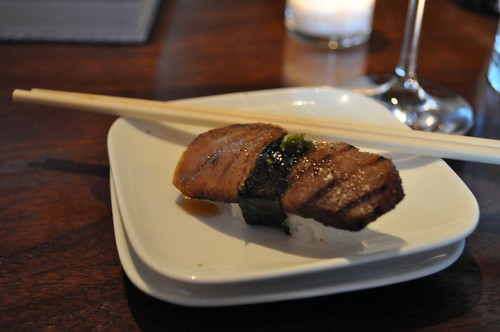
On the recommendation of a local, I had a meal at Uchiko my last night in town. You can read all about it over at Eating Our Words. I thumbed through their cookbook while I ate my Fried Milk dessert, immediately knew I had to own a copy. Armed with the cookbook featuring fantastic cooking techniques and my lingering Uchiko-buzz, I attempted a new dish inspired by Cole and his cookbook (by the way, you really should a copy of it). You can click on this link to see more of the Uchiko food porn shots.
I came across a recipe for tuna steak coupled with compressed watermelon and other fancy accoutrements I chose to skip. I don’t really have a recipe for this, I’ll simply walk you through the method. This was very easy and quick to put together. I decided to allow the tuna steaks to marinate for about an hour and at the same time this allowed me time to dehydrate the watermelon slices.
Tuna Steaks with Dehydrated Watermelon
serves 2
For the steaks:
2 tuna steaks, marinated
Marinade:
2 tbsps extra virgin olive oil
Crushed black pepper
Sea salt

Dehydrated Watermelon
4 watermelon slices (about 1/2-in thick)
Fish sauce
Cooling rack
Remove any seeds and sprinkle each side of the watermelon slices with a couple drops of the fish sauce. Then place them on the cooling rack over a cookie sheet and allow some of the liquid to drain out of the watermelon.

Peach & Habanero Sauce
2-3 ripe peaches, peeled & diced
Water
Pinch of salt
Habanero sauce, to taste
Throw everything, except the water, into a small saucepan. Add enough water just to come to the tops of the peach cubes, bring it to a slow boil/heavy simmer and cook until the peaches have softened to mush. Keep warm.
Sear the steaks in a nonstick skillet, we like ours medium rare, but cook it to your preference. Lay 2 slices of watermelon, spread a bit of the peach sauce and top with the seared tuna steaks.

I know this combination of ingredients may sound odd, but it really works. The tuna steaks were simply flavored, so you can really appreciate their flavor. The watermelon, which is always just mildly sweet, is accented by the complex saltiness of the fish sauce and all of this balanced out by the fresh sweetness and spiciness of the peach sauce. It was a perfectly harmonized dish.
Enjoy!
Cookingly yours,
Anamaris

This is a recipe I found in Jorge Jurado’s cookbook, Sabores de Panamá. I should tell you it isn’t a ‘traditional’ Panamanian dish, but rather an interpretation by this talented chef utilizing ingredients commonly found in Panama. His recipe called for beef shanks, but I had just picked up some short ribs and decided to use them instead. It turned out beautifully.
The intense combination of spices, together with the deep and rich color of the final dish made this reminiscent of Mexican mole. I can’t really think of a traditional Panamanian dish that is even remotely similar to mole, but this is a rocking interpretation!
Costillas Braseadas con Cafe, Chocolate y Anis Estrellado (Coffee, chocolate and anise braised short ribs)
Marinade – a day ahead
2-1/2 lbs short ribs
1/2 bottle red wine (one you would drink)
3 garlic cloves, diced
1 tbsp instant coffee
2 carrots, sliced
1 bay leaf
12 peppercorns
2 star anise pods
2 tbsps olive oil
1 tbsp salt
Combine all the ingredients in a ziploc bag and allow the ribs to marinate overnight or, at least for a few hours. Turn the ribs occasionally.

Braising – day of
1-1/2 onions, chopped
4 garlic cloves, chopped
Marinated ribs and the carrots
Extra virgin olive oil
Approx 2 cps broth (chicken/beef/veg)
1 tbsp sugar
1 oz bittersweet chocolate
Salt to taste
Remove the ribs from the marinade and pat dry with a paper towel. Meanwhile, heat a Dutch oven to medium-high and add the olive oil. Brown the dry ribs on all sides, remove from the pan and set aside.
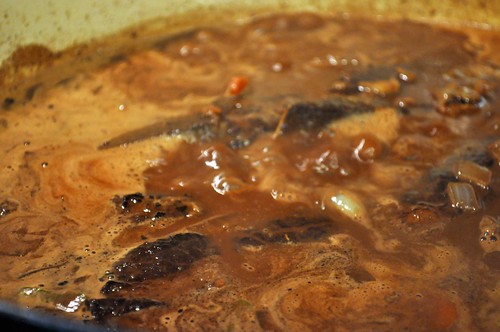
Drain the excess fat, leaving about 2 tbsp of oil/fat in the pan. Add the onions, garlic and carrots and allow to cook until they begin to caramelize. Return the ribs to the pan and add the marinade liquid, broth, sugar and chocolate.
There should be enough liquid for the ribs to be completely submerged. Bring it to a boil, then reduce the temperature to low to allow for a slow simmer. This will continue to simmer for about 2 hours, until the meat is tender and falling off the bone.

I, of course, served it over rice. I love rice, sue me! I think it would be really nice with roasted veggies too, though. For more food porn, click here.

Cookingly yours,
Anamaris
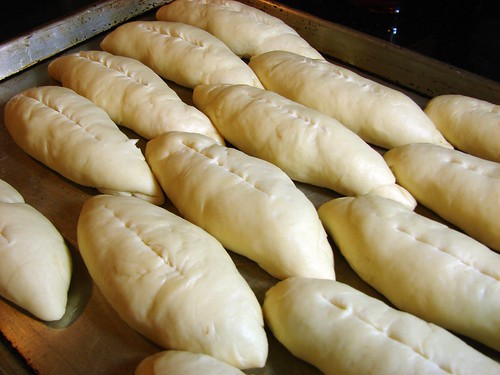
I’ve always found that to be an odd expression. The phrase itself sounds innocuous to me, but the meaning behind it makes sense. To share, to open one’s home and/or heart to another, to be welcoming. Philosophically, the idea of breaking bread is a great one. In reality, the idea of having to share my bread with someone, elicits murderous thoughts. No. Really. Don’t touch my bread!
Luckily, when I bake bread, the recipe results in enough of it that I’m able to, even if begrudgingly, share it with one or two people. Tops. You get the picture. So, a few weeks ago I made some bread. Panamanian bread, something we call Pan Micha.
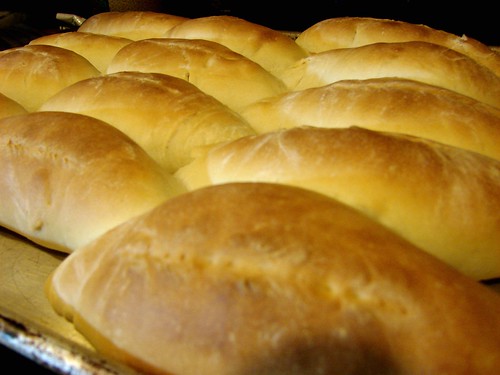
Rumor has it, this recipe was brought to my homeland by the French when they attempted building the Canal. I have no verification for that story, but I do recognize some similarities with French miche bread. Thin, golden crust and soft, light inside. What I do know for sure, if that you will find michitas anywhere there is a bakery in Panama.
I remember walking to school and stopping by the corner bakery–the aroma of freshly baked bread wafting in the air–and ordering ‘una michita con queso blanco y mantequilla‘ (a buttered michita stuffed with white cheese). Aaaaah, the bread would still be warm, the butter and local cheese melting into the center. Heavenly.
I found a recipe for it here, so I won’t retype it, just follow the link. What I want to tell you about, is how we ate them, after all, eating them is the best part.
You know I’m a traditionalist, so mine had butter and Queso Fresco. Nothing else needed. I did toast them a bit.
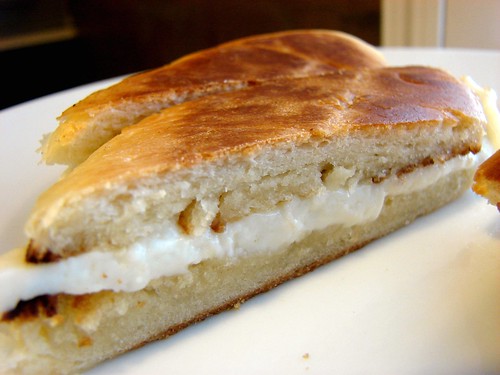
The Hubbz is a different story. He’s a man of excess, so he added some roast beef we had in the fridge. In Panama, we would’ve used ham or chorizo.

The bread was good, but not as light and airy as I remember michitas being, my quest for the perfect recipe continues.
Cookingly yours,
Anamaris
Remember these?
Patacones or Tostones (fried green plantains)

Bacon-wrapped asparagus
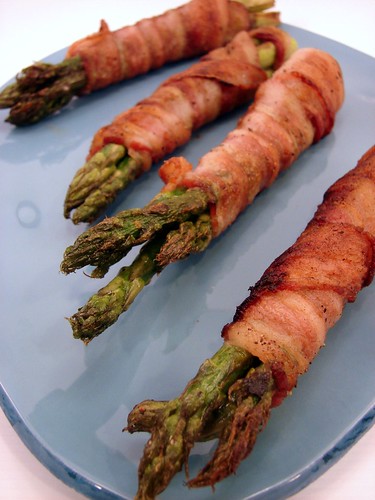
Salmon with Beurre Blanc Sauce
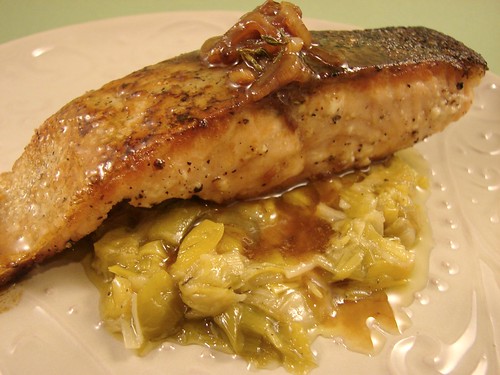
Lavender-Crusted Lamb
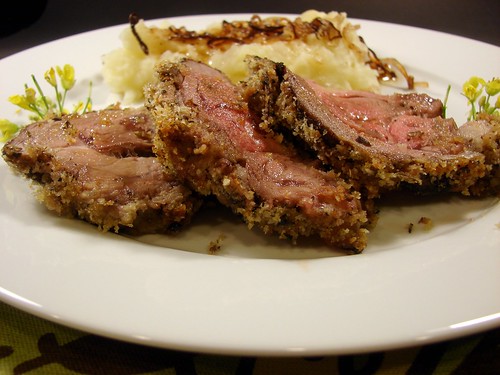
Seared Scallops with Red Pepper Sauce
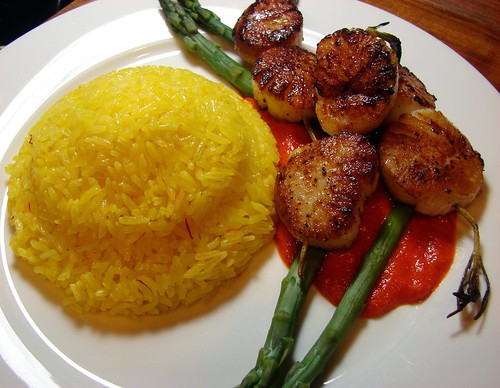
Kick-ass Pasta Salad

Hungry yet?
Cookingly yours,
Anamaris

With Spring almost over and Summer staring me right in the face and its heat chasing me around Houston, I’ve had no choice but to start thinking about lighter, cooler meals. I’m also supposed to be making an effort to eat healthier, which is always a battle for me, but I’m trying–get off my back already!
So, since I’m not the biggest salad fan, I have to find ways to get them in, but they have to be interesting. That’s how this one came about. For some reason I found thoughts of sofrito running around my head; I guess that’s not so unusual, since that is the base to almost every Latin/Caribbean dish. Onions, bell peppers, garlic, tomatoes, culantro and sometimes carrots –standards in most sofritos. Then the lightbulb moment happened: I bet that would make for a good salad! Add some cheese, a vinaigrette, oooooh roast the veggies…YUM!
And so it happened. And, let me tell you. Oh.eM.Gee! This turned out so amazingly delicious! I roasted everything in the oven for a few minutes to bring out the natural sweetness of the ingredients and to tame the zing of the onion and garlic. You can opt to use them fresh, uncooked, but I do hope you take a few minutes to roast them, because, well, its just heavenly. No real recipe here, just a bit of this and that. Make it! Do it today!
Roasted Sofrito Salad
Sweet or red onion
Red & orange bell peppers
Garlic, whole
Baby carrots
I sliced the onion and peppers into 1/4-in or so pieces, not too big, not too small. Left the garlic and baby carrots whole. If you go for regular-sized carrots, then cut them into sticks. You want the veggies to still have a bite to them after roasting.
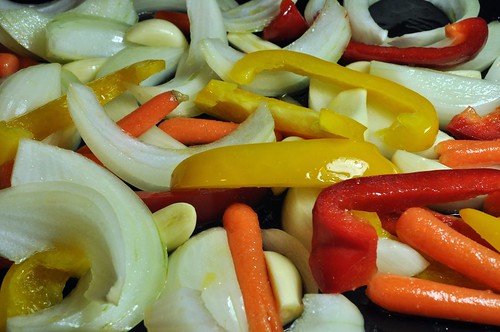
I threw it all onto a lined baking sheet, drizzled about 1-2 tbsp of extra virgin olive oil, a sprinkling of salt & pepper and popped it all under the broiler. I tossed the veggies around after 5 minutes or so, when they starting caramelizing, I didn’t want them to burn. 10 minutes was enough. Allow them to cool, while you work on the vinaigrette.
Culantro Vinaigrette
Culantro/cilantro, chopped
Extra virgin olive oil
White wine vinegar
Salt & fresh black pepper
Blend the culantro into the oil to puree. Remove from blender, add vinegar, then slowly drizzle in the culantro oil until creamy. Adjust seasoning as necessary.
Plating
Iceberg lettuce wedges, very cold
Tomatoes, wedges
Culantro vinaigrette
Queso Cotija or Fresco
Combine the roasted veggies with the lettuce, add tomato wedges and dress with the vinaigrette. Serve with crumbled Cotija or Queso Fresco. Ay, que rico!
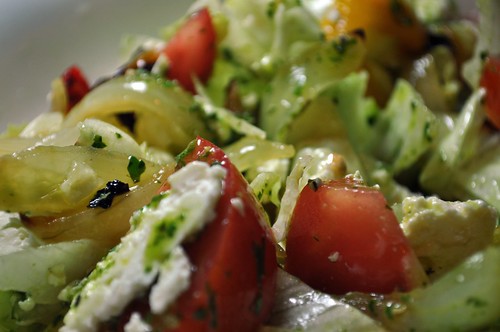
Freshly yours,
Anamaris

My dear friend Shun, as I affectionately call her, shared this dish with me many moons ago, and I was hooked after my first try. Fideos (noodles) are a simple symphony of spicy, smoky and fresh flavors. It is sometimes called sopa de fideos, which translates to dry noodle soup.
It makes for a great side dish, but I often eat it as a main course. Traditionally, it is served with crema fresca (creme fraiche), queso fresco and avocado. A great option for a meat-free menu, and delicious to boot. Another plus, it is prepared in a jiffy or rápidito! I made this batch at the last minute to take to a party and was unable to find tomatoes that were ripe enough, so I opted for good canned ones. Likewise, I had no luck in the avocado front, so no avocados for me! You decide how much heat you want and adjust the number of serranos accordingly, you may also remove the seeds, this will further reduce the heat level.
Fideos a la Shun
12 oz fideo pasta or angel hair
4 tbsp olive oil
1 medium onion
2 garlic cloves, whole
1 or 2 serrano peppers, to taste
5 fresh Roma tomatoes, ripened OR
1 can (15 oz.) stewed tomatoes
2 tbsp chicken flavor bouillon (like Knorr or Maggi)
Water
1/2 tsp dried oregano
1/2 tsp cumin powder
Salt and pepper to taste
For plating:
Queso fresco, crumbled
Crema fresca
Avocado slices or small cubes
I would suggested getting the sauce ready first. Shun’s recipe calls for the onion, garlic, serranos and fresh tomatoes to be roasted first. You can skip this step, but it does add an intensity and complexity to the dish, so if you have the time–about 10-15 extra minutes–you should do it.

I use my comal or grill pan for this, getting it nice and hot, then sear the sliced onion, whole serranos, garlic and tomatoes (fresh). Once seared, dump the whole thing into your blender or food processor, adding the chicken bouillon, cumin, oregano, salt & pepper and enough water to get things moving. Set aside.
Heat a large saute pan over high heat add the oil and break the pasta into it, the purpose of this step is to toast the pasta, but don’t walk away, it burns rather quickly and that will ruin the flavor of the dish. The noodles will change color and turn golden brown.
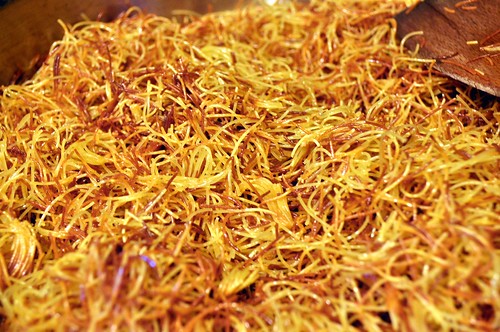
Carefully, VERY carefully add the pureed sauce and watch yourself! It becomes the evil spitty monster at this point, add enough water to ensure the noodles are submerged in liquid. Lower the heat so it simmers gently, check the seasoning and adjust as necessary.
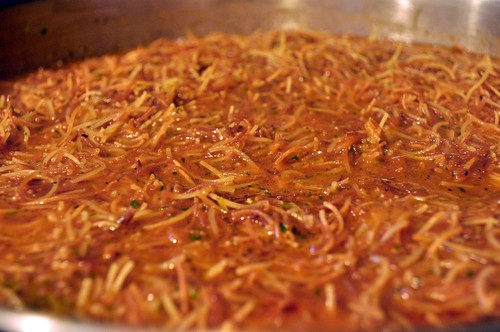
The noodles should be al dente, when done. It will take about 20 minutes for the pasta to cook and you may need to add more water as it cooks down. To plate: spoon some noodles onto a plate, top with crema, avocado and the crumbled cheese. Pull up a chair and enjoy!

To see more of the step-by-step process, click here.
Cookingly yours,
Anamaris
PS: Thanks, Shuni!
